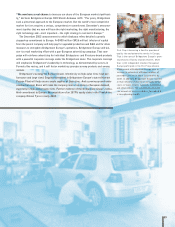Bridgestone 2002 Annual Report Download - page 21
Download and view the complete annual report
Please find page 21 of the 2002 Bridgestone annual report below. You can navigate through the pages in the report by either clicking on the pages listed below, or by using the keyword search tool below to find specific information within the annual report.
19
Sales were essentially unchanged in Japan as strength in the
tire segment more than offset a revenue decline in other products.
The Companies’ Japanese unit sales of tires were basically
unchanged in the replacement and original equipment markets,
but the Japanese sales total benefited from growth in exports
to nonconsolidated distributors in the Middle East and other
regions.
The Company continued to strengthen its affiliated tire retail
channels in Japan during the year. Those channels center on large-
volume tire and automotive maintenance stores operated directly
by regional domestic sales companies under the Tire Kan name;
neighborhood tire shops operated by independent retailers who
have adopted the Company’s Mr. Tire Man signage and service
guidelines; and Cockpit automotive accessory shops, which cater
to young automotive aficionados. The domestic retail channels
included 436 Tire Kan stores, 597 Mr. Tire Man shops and 177
Cockpit outlets at 2002 year-end.
In the Americas, the Companies’ operations posted strong
growth in unit sales of truck and bus tires. They also recorded
unit sales growth in passenger car and light truck tires as gains
in the replacement market, led by Bridgestone-brand tires, more
than offset a decline in original equipment tires. Also contributing
to sales growth on a yen-denominated basis was the weakening of
the Japanese currency against the U.S. dollar during the year.
The Companies’ operations in Europe posted unit sales gains
in passenger car and light truck tires and also in truck and bus
tires. Underlying the sales gains in truck and bus tires was growth
in sales to manufacturers of truck tractors and trailers. The
Companies supplemented that growth by cultivating business
with large fleet operators and by strengthening their network
of affiliated dealers. The weakening of the yen against the euro
amplified the yen-denominated growth in European sales.
Sales gains in several markets, including China, Southeast Asia,
India, the Middle East and Africa, accounted for the strong sales
growth posted by the Companies in other regions. Business in China
is expanding especially rapidly as the Companies expand their retail
sales networks and their local production capacity. Middle Eastern
sales increased solidly in 2002 in reflection of rising oil prices.
Sales by customer location
In sales by customer location, sales to customers in Japan declined
2.2%, to ¥739.7 billion ($6,169 million). Sales in the Americas
increased 6.8%, to ¥976.9 billion ($8,147 million). In Europe,
sales increased 9.2%, to ¥248.2 billion ($2,070 million). Sales in
other regions—including Asian nations besides Japan, Australia,
New Zealand, Africa and the Middle East—increased 20.3%, to
¥283.0 billion ($2,360 million).
Sales by industry segment
In sales by industry segment, the Companies’ business in tire opera-
tions increased 6.5% over the same period of the previous year,
to ¥1,797.6 billion ($14,992 million). That increase reflected the
positive effect of the weakening yen on yen-denominated sales. It
also reflected successful introductions of new products and progress
in expanding sales channels.
Tire products handled by the Companies include tires for passen-
ger cars and light trucks, for trucks and buses, and for earthmoving
equipment, agricultural machinery, aircraft, subway trains and
motorcycles. The Companies together are the world’s largest sup-
plier or one of the three largest suppliers in each principal category
of tire products.
Sales in other operations increased 0.8% over the same period
of the previous year, to ¥450.2 billion ($3,755 million). The
Companies’ business in diversified products includes vibration-
98 99 00 01 02
¥ billion
500
1,000
1,500
2,000
2,500
0
Net sales
Sales of tires
98 99 00 01 02
¥ billion
400
800
1,200
1,600
2,000
0
Currency exchange rates
(annual average rates)
98 99 00 01 02
¥
30
60
90
120
150
0
¥/$
¥/e
























